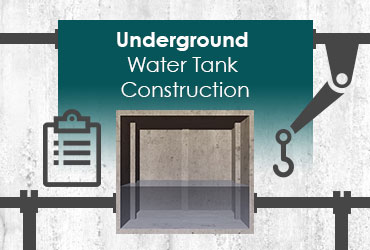Building an underground water tank is one of the most vital ways of protecting your home or business against the danger and devastation of a bush fire. It can be a lengthy process, but if you plan every section of the build comprehensively and make sure your contractors are prepared for every eventuality, you’ll be able to get your underground water tank completed and doing the job it was built for within a matter of weeks.
Planning Stages
To begin your water tank construction project, you’ll need to have the whole thing planned out to avoid any problems further down the line. Things to think about first of all are:
- Where are you going to put it?
- Do you have permission?
- Is the area safe?
- How big does it need to be/what capacity is right for you?
- What are you using it for?
- Is there enough space surrounding your chosen plot for machinery to operate?
Let’s look at each of these points in a little more detail, then:
Where are you going to put it?
Thinking about where your underground tank will go takes a little more creative thinking than simply marking out a space next to your home or business. You’ll need to think about gaining planning permission, and you’ll also need to check the area for underground pipes and cables…which leads us on to our next point:
Do you have permission?
Building an underground storage tank on your land isn’t as simple as digging a big hole and pouring in a load of concrete. Before you even begin to excavate, you’ll need to make sure that any permits from your council have been applied for and accepted. These can include assuring the council and your neighbours that your installation will keep to within your boundary lines, or away from set fences or other buildings.
Is the area safe?
Before you get digging, you will also need to check that the surrounding land has no electricity, gas, sewer, telephone, mains water or stormwater services. You can find the plans for these through your local authorities. If the area you’ve chosen to install your tank is prone to flooding or tidal activity, you will need to seek an alternative installation method, which your excavator or concrete supplier can help you with.

How big does it need to be?
There are many different sizes of underground water tanks, and Versatile Tanks custom build a range of domestic water tanks in sizes ranging from 6700 litres to 22500 litres. There are benefits to both small and larger tanks:
Small tanks mean you need less space to install them, their cost is reduced, and you might not need as much manpower to construct the finished article.
Building a large tank means that although it takes up more space underground, you won’t need to think about replacing it for a larger model in the future, or even adding to your storage capacity once it has been installed.
What are you using it for?
Of course, if you’re buying an underground water tank to store water, the answer to this is in the name. However, we have many clients who use Versatile Tanks for a number of different jobs. Hence the ‘Versatile’ part in our name.
The robust nature of our bespoke concrete tanks makes them ideal for storing hazardous waste, and even chemicals. We have provided our strong concrete tanks for underground storage for commercial businesses and farms who needed the extra storage space. We also create dangerous goods storage tanks, for the safe storage of explosives, using specialist safe locks, double pallet doors and bespoke ventilation.
Some underground storage tanks are fancier than others though. We also provide tanks that can be fitted out as wine cellars, complete with spiral staircase and racking to house those precious vintages. As our concrete tanks don’t conduct heat, the temperature remains ambient, which is perfect for storing special bottles of wine, port, and even beer.
Is there enough space around the unit?
The space needed to complete an underground water tank must also include 2.5 meters around the perimeter. This will allow the necessary heavy machinery to come in and do their work. This includes excavators and lifting equipment.
There is plenty more advice on excavating for your tank and much more in our installation infographic.
Installing your tank
When you’re installing your tank, it’s a very good idea to have professionals on hand to solve any issues that may occur and keep the project running efficiently. If you’re purchasing your tank from us, we will of course help you every step of the way, from planning and excavation to installing and adhering to safety regulations.
A really useful person to have on-hand is a geotechnical specialist, who will have the experience and skills to help you overcome any site installation issues. If your project is large, or you feel that the expert support would be beneficial, a site supervisor would also be useful. They will be able to keep track of all the work being carried out, ensure that everything is running to time, and can even make sure that the necessary machinery and equipment is leased in time for the work to be carried out.
Some other things to think about:
- Renting a crane
- Purchasing your pump system
- Order washed sand for the base and ballast mix for backfill.
How to rent a crane
When you book your crane, make sure you plan ahead so that work cannot be halted due to overhead powerlines and other dangers. It’s a really good idea to ask the crane operator, or at least a representative from the company you are hiring to carry out this work, to check your site beforehand so they can plan accordingly.
Purchasing a pump system
If you plan to use your underground tank as a water tank system, you will need to make sure your water pump is ordered and will arrive in time for installation. The type of pump you buy will depend on how you plan to use your tank. If you’re considering using the water stored in your tank for high-pressure tasks such as in a washing machine or in a toilet system, you will need to ensure that it complies. Ask the pump manufacturer for more details if you’re not sure.
Order washed sand and ballast
Another one of those things you’ll need to think about is getting hold of the raw materials needed for the actual construction of your tank.
Washed sand and ballast or backfill are vital to the safe construction of your unit, and the continued stability of the tank. Talk to your installers for more information.
Using and Checking your Tank
Once your tank is installed, make sure you let it settle into place before using it. Once the ground has settled on top of the tank, you’ll also be able to build on top of it. Usually, our customers choose to place a driveway over the top, hiding the tank from sight and giving them the extra storage space they need.
Any potential problems should present themselves in the first few days of use, but using a Versatile Tank mean problems are highly unlikely. Keep checking over time that your tank is as effective as it always was (no leaks, for example) and you’ll have an underground water tank that’ll serve you well for decades to come.

